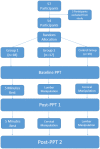Spinal manipulation does not affect pressure pain thresholds in the absence of neuromodulators: a randomized controlled trial
- PMID: 28912629
- PMCID: PMC5592341
- DOI: 10.1080/10669817.2016.1230352
Spinal manipulation does not affect pressure pain thresholds in the absence of neuromodulators: a randomized controlled trial
Abstract
Background: Measurement of pressure pain threshold (PPT) is a way to determine one of the many potential treatment effects of spinal manipulative therapy.
Objective: To determine how multiple spinal manipulations administered in a single-session affected PPTs at local and distal sites in asymptomatic individuals.
Methods: Participants were randomly assigned into one of three groups: Group one (n = 18) received a lumbar manipulation followed by a cervical manipulation. Group two (n = 17) received a cervical manipulation followed by a lumbar manipulation. The control group (n = 19) received two bouts of five minutes of rest. At baseline and after each intervention or rest period, each participant's PPTs were obtained using a handheld algometer. The PPTs were tested bilaterally over the lateral epicondyles of the humerus and over the mid-bellies of the upper trapezius, lumbar paraspinal, and the tibialis anterior muscles. This study was registered with ClinicalTrials.gov, and its Identifier is NCT02828501.
Results: Repeated-measures ANOVAs and Kruskal-Wallis tests showed no significant within- or between-group differences in PPT. Within-group effect sizes in the changes of PPT ranged from -.48 at the left paraspinal muscles to .24 at the left lateral humeral epicondyle. Statistical power to detect significant differences at α of 0.05 was calculated to be 0.94.
Conclusions: This study suggests that in young adults who do not have current or recent symptoms of spinal pain, multiple within-session treatments of cervical and lumbar spinal manipulation fail to influence PPTs. Changes in PPT that are observed in symptomatic individuals are likely to be primarily influenced by pain-related neuromodulators rather than by an isolated, mechanical effect of spinal manipulation.
Keywords: Neuromodulation; pain mechanisms; spinal pain.
Figures
Similar articles
-
The regional effect of spinal manipulation on the pressure pain threshold in asymptomatic subjects: a systematic literature review.Chiropr Man Therap. 2018 Apr 19;26:11. doi: 10.1186/s12998-018-0181-3. eCollection 2018. Chiropr Man Therap. 2018. PMID: 29713457 Free PMC article.
-
Immediate changes in widespread pressure pain sensitivity, neck pain, and cervical range of motion after cervical or thoracic thrust manipulation in patients with bilateral chronic mechanical neck pain: a randomized clinical trial.J Orthop Sports Phys Ther. 2012 Sep;42(9):806-14. doi: 10.2519/jospt.2012.4151. Epub 2012 Jun 18. J Orthop Sports Phys Ther. 2012. PMID: 22711239 Clinical Trial.
-
Immediate hypoalgesic and motor effects after a single cervical spine manipulation in subjects with lateral epicondylalgia.J Manipulative Physiol Ther. 2008 Nov-Dec;31(9):675-81. doi: 10.1016/j.jmpt.2008.10.005. J Manipulative Physiol Ther. 2008. PMID: 19028251 Clinical Trial.
-
Immediate effects on electromyographic activity and pressure pain thresholds after a cervical manipulation in mechanical neck pain: a randomized controlled trial.J Manipulative Physiol Ther. 2011 May;34(4):211-20. doi: 10.1016/j.jmpt.2011.02.002. Epub 2011 Mar 21. J Manipulative Physiol Ther. 2011. PMID: 21621722 Clinical Trial.
-
How big is the effect of spinal manipulation on the pressure pain threshold and for how long does it last? - secondary analysis of data from a systematic review.Chiropr Man Therap. 2019 Apr 24;27:22. doi: 10.1186/s12998-019-0240-4. eCollection 2019. Chiropr Man Therap. 2019. PMID: 31049195 Free PMC article.
Cited by
-
The regional effect of spinal manipulation on the pressure pain threshold in asymptomatic subjects: a systematic literature review.Chiropr Man Therap. 2018 Apr 19;26:11. doi: 10.1186/s12998-018-0181-3. eCollection 2018. Chiropr Man Therap. 2018. PMID: 29713457 Free PMC article.
-
Duration of Electro-Dry Needling Does Not Change the Pain Response After Repeated Nociceptive Thermal Stimuli in Asymptomatic Individuals: A Randomized Intervention Study.Arch Rehabil Res Clin Transl. 2023 Apr 17;5(2):100267. doi: 10.1016/j.arrct.2023.100267. eCollection 2023 Jun. Arch Rehabil Res Clin Transl. 2023. PMID: 37312978 Free PMC article.
References
Associated data
LinkOut - more resources
Full Text Sources
Other Literature Sources
Medical



